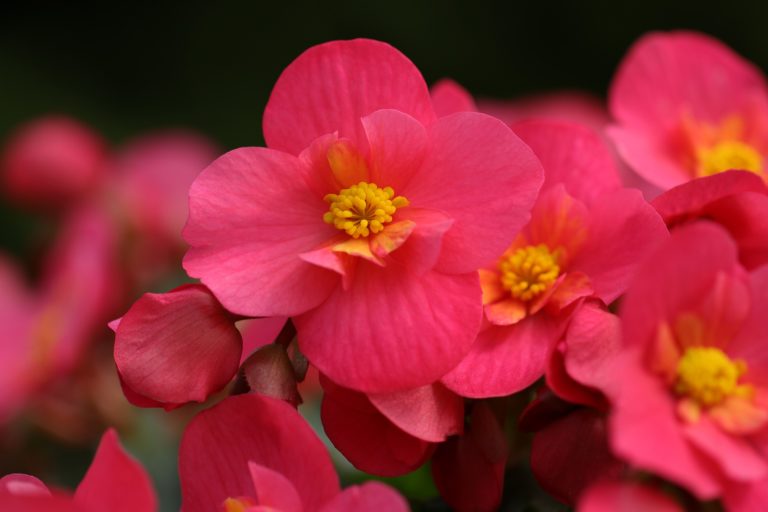Begonias are beautiful flowering plants that come in a wide array of colors and forms making them a favorite for gardeners. Many gardeners grow begonias from tubers started indoors. But starting begonias from seeds indoors is also an excellent option. This allows you to grow lots of begonias from just a small packet of seeds.
When is the best time to start begonia seeds indoors? Begonias started from seeds require time and care to produce healthy transplants ready for the garden. Follow this complete guide to understand when and how to start begonia seeds indoors successfully.
When to Start Begonia Seeds Indoors
The timing of starting begonia seeds indoors depends on whether you are growing tuberous or fibrous rooted types.
Fibrous Rooted Begonias
For fibrous rooted begonias like wax, cane, angel wing, dragon wing, and semperflorens types, start seeds indoors 10-12 weeks before your last expected spring frost date.
This allows enough time for the seeds to germinate and for seedlings to develop into sturdy transplants that can be moved outdoors once danger of frost has passed.
Tuberous Begonias
For tuberous types grown from seeds, start earlier at 14-16 weeks before your outdoor planting date.
Tuberous begonia seeds require more time to produce tubers that will bloom well in the garden.
How to Start Begonia Seeds Indoors
Follow these steps for successfully starting begonia seeds indoors:
Get High Quality Seeds
- Purchase fresh begonia seeds from reputable suppliers for best germination rates. Look for wax begonia, rex begonia, semperflorens, and tuberous begonia seeds.
Use Proper Seed Starting Mix
- Fill containers with a sterile, lightweight seed starting mix. This provides good drainage and nutrients.
Provide Warmth
- Begonias need consistent warmth between 70-75°F (21-24°C) to germinate well. Use a heat mat or other method to maintain temperature.
Sow Seeds Correctly
-
Plant seeds just below the mix surface. Begonias need light to germinate.
-
Water gently to avoid dislodging small seeds. Consider bottom watering.
Give Bright Indirect Light
- Place seedlings under grow lights or near a sunny window covered with sheer curtains. Avoid direct hot sunlight.
Maintain High Humidity
- Cover seed containers with plastic domes or plastic wrap. This keeps humidity levels ideally high.
Transplant and Harden Off
-
Transplant into pots once seedlings have 2-3 sets of true leaves.
-
Gradually expose to outdoor conditions over 7-10 days before planting in garden after frost danger has passed.
Tips for Success With Begonia Seeds
Follow these tips to overcome common challenges and get great results starting begonia seeds indoors:
-
Provide consistent moisture and temperatures. Fluctuations cause poor germination.
-
Use sterile tools and containers to prevent fungal disease.
-
Thin overly crowded seedlings to prevent problems.
-
Fertilize lightly every 2-3 weeks once true leaves develop.
-
Handle new seedlings carefully by their leaves when transplanting to avoid damage.
With the right timing and care, growing begonias from seeds indoors is very rewarding. In 10-16 weeks, you can have beautiful transplants ready to brighten your garden with a multitude of colors.
How To Start Begonias From Seed || Starting Begonia Seeds
FAQ
Are begonias hard to start from seed?
When to start begonia tubers indoors?
What month do you start begonia tubers?
When to start waxing begonia seeds indoors?
Can you grow begonias indoors?
Adequate light is critical during the early stages of growing begonias from seed. If natural sunlight is limited in your location (especially during late winter/early spring), consider investing in fluorescent grow lights specifically designed for starting seeds indoors. Start sowing indoors 10-12 weeks before the last frost date in your area.
When do begonias grow?
Like other plants from tropical climates, begonias grow best in warm weather. If you start the tubers indoors, several months before the last frost, your plants will begin blooming in early summer. The closer it gets toward spring, the more quickly the tubers will sprout.
Can you grow begonias from seed?
Annual flowers are definitely not the most expensive plants at your local greenhouse, but if you grow (or sell) a lot of them, starting your own from seed can save you a ton of money. While starting marigolds, cosmos and salvias from seed is as simple as can be, when you start begonias from seed, it requires a bit more time and effort.
What is the best temperature to grow begonias from seed?
Maintaining the correct temperature is also vital when growing begonias from seed. These plants prefer warm conditions but are sensitive to extreme heat or cold. The optimal temperature range for begonia seed germination is between 70-75°F (21-24°C).

